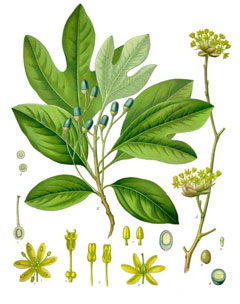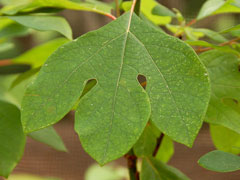Plant Portrait - Sassafras albidum Sassafras
 Sassafras is a deciduous tree from Eastern North America that grows wild in deciduous woodlands and thickets on rich sandy well-drained soils. It can grow up to 25 metres tall with a spread of 16 metres but is very unlikely to reach this size in Britain where it commonly becomes no more than a small tree or large shrub. It will usually fit very well into a garden where it can be grown as a specimen plant in the lawn. It will also eventually make a good canopy tree for the sunnier edges of a woodland garden.
Sassafras is a deciduous tree from Eastern North America that grows wild in deciduous woodlands and thickets on rich sandy well-drained soils. It can grow up to 25 metres tall with a spread of 16 metres but is very unlikely to reach this size in Britain where it commonly becomes no more than a small tree or large shrub. It will usually fit very well into a garden where it can be grown as a specimen plant in the lawn. It will also eventually make a good canopy tree for the sunnier edges of a woodland garden.
The plant is quite easy to grow, it prefers a deep, fertile, well-drained, lime-free, near neutral soil in sun or light shade. Young plants are quite frost tender and so it is best to either grow them on for their first few years in pots, or to plant them out under the shelter of other trees which should give them just enough protection. Even on older trees, the young spring growth can be damaged by late spring frosts and therefore it is a good idea to site the plant where it will be sheltered from the early morning spring sun.
Sassafras is a very ornamental tree with quite large leaves that can vary quite dramatically in shape even on the same tree. All parts of the tree contain essential oils and give off a pleasant spicy aroma when crushed. A long-lived and moderately fast-growing tree, it is virtually free of pests and diseases in this country. Trees can begin flowering when only 10 years old and, in the wild, good seed crops are usually produced every 2 - 3 years. However, if you want to produce seed in Britain then you need to grow at least two trees since individual plants are either male or female. Trees also spread or be propagated by root suckers and can form thickets in the wild though they do not seem to sucker so freely in Britain.
This is a tree with a multitude of uses, it was widely employed by the native American Indians and is still commonly gathered from the wild for its medicinal virtues. We will look first at its edible uses. The young leaves can be eaten raw as a component in mixed salads whilst both young and old leaves can be used as a flavouring and as a thickening agent in soups etc. They have a mild aromatic flavour. Older leaves can also be dried and ground into powder for later use.
 The whole plant is pervaded by an aromatic essential oil and it is still commonly used as a food flavouring with considerable health benefits. The dried root bark can be boiled with sugar and water until it forms a thick paste. It is then used as a condiment. The root and the berries can also be used as flavourings.
The whole plant is pervaded by an aromatic essential oil and it is still commonly used as a food flavouring with considerable health benefits. The dried root bark can be boiled with sugar and water until it forms a thick paste. It is then used as a condiment. The root and the berries can also be used as flavourings.
A tea is made from the root bark, it is considered to be a tonic. The tea can also be made by brewing the root in maple syrup, this can then be concentrated into a jelly if required. Teas are made from various other parts of the tree. In spring the leaves and roots are used together and in early summer the flowers are used.
Sassafras is still a commonly used herbal preparation with a wide range of actions. A tea made from the root bark is particularly renowned as a spring tonic and blood purifier as well as a household cure for a wide range of ailments such as gastrointestinal complaints, colds, kidney ailments, rheumatism and skin eruptions. The mucilaginous pith from the twigs has been used as a poultice or wash for eye ailments and is also taken internally as a tea for chest, liver and kidney complaints.
An essential oil obtained from the root bark is used as an antiseptic in dentistry and also as pain killer. The oil contains safrole, which is said to have carcinogenic activity and has been banned from use in American foods - though there is plenty of modern research which shows that it is less likely to cause cancer than alcohol. In large doses, however, the oil is poisonous, causing dilated pupils, vomiting, stupor, collapse and kidney and liver damage. The oil has been applied externally to control lice and treat insect bites, though it can cause skin irritation in some people. The essential oil is also used in soaps, the coarser kinds of perfumery, toothpastes, soft drinks etc.
The growing plant repels mosquitoes and other insects, so it is a beneficial companion plant in the garden. Dried leaves will add a pleasant but delicate scent to the room whilst also helping to keep insects away.
 Propagation is fairly simple from seed. If you can obtain it, fresh seed will give the best results and this should be sown immediately in a cold frame. It should germinate in the spring. If you can only obtain stored seed then this will need four months cold stratification at 4°c. Soaking the seed for 24 hours in warm water and then mixing it with some damp compost and placing it in the salad compartment of the fridge for 3 4 months should suffice. As soon as they are large enough to handle, prick out the seedlings into individual pots and grow them on in the greenhouse for at least their first winter before planting them out. Give the young trees some protection for at least their first winter outdoors[K].
Propagation is fairly simple from seed. If you can obtain it, fresh seed will give the best results and this should be sown immediately in a cold frame. It should germinate in the spring. If you can only obtain stored seed then this will need four months cold stratification at 4°c. Soaking the seed for 24 hours in warm water and then mixing it with some damp compost and placing it in the salad compartment of the fridge for 3 4 months should suffice. As soon as they are large enough to handle, prick out the seedlings into individual pots and grow them on in the greenhouse for at least their first winter before planting them out. Give the young trees some protection for at least their first winter outdoors[K].
Suckers can be dug up in late winter. If they are well-rooted they can be planted straight out into their permanent positions but if the root system is rather sparse it is best to pot them up and place them in a lightly shaded place in the greenhouse until they are growing away strongly. In addition root cuttings can be taken from the suckers. These cuttings should be about 1 - 2cm long, they are taken in December and planted horizontally in pots in a greenhouse. Grow them on for their first winter in the greenhouse before planting them out into their permanent positions.
Plant Database
The database has more details on these plants: Sassafras albidum.